Research on the Impact of Digital Economy on Manufacturing Total Factor Productivity
Abstract
:1. Introduction
2. Theoretical Analysis and Literature Review
2.1. Theoretical Analysis
2.2. Literature Review
3. Characteristic Facts and Data Analysis
4. Methodology
4.1. Methodology
- Entropy weight evaluation method. The number of indicators included in the measurement of the digital economy index is large, so the entropy weighting method is selected to determine the weight of each indicator. The entropy method is an objective weighting method, which has the advantage of avoiding subjectivity in weighting, and it is consistent with the mathematical laws, and has a strict mathematical meaning.
- 2.
- Panel model construction. To verify the impact of the digital economy on promoting TFP in manufacturing, the following model is constructed:
- 3.
- Regional difference analysis. The Gini coefficient is used to quantitatively measure the difference of income distribution. Dagum (1997) proposed the decomposition method of the Gini coefficient, which decomposed the overall Gini coefficient into intra-regional difference , inter-regional difference , and super-variable density contribution , which could reveal the regional difference and the source of the difference in the development of the digital economy [50]. The calculation process is as follows:
4.2. Variable Description
- Explained variable: manufacturing TFP. The research samples for this paper are manufacturing enterprises listed on Shanghai and Shenzhen A-shares from 2011 to 2020. In accordance with existing literature, we process the original data at the enterprise level as follows:
- 2.
- Core explanatory variables: digital economy (DIGI)
- 3.
- Control variables: technology research and development (R&D), as measured by R&D expenditures of large industrial enterprises [55]; economic development level (GDP), wherein the level of economic development in a region is expressed as GDP, and foreign direct investment (FDI) is expressed as the total value of foreign capital used in the current fiscal year; level of education (education), as measured by the average number of college students per 100,000 population; and government intervention (finance), as manifested in general budget expenditure.
5. Empirical Results and Analysis
5.1. Sub-Regional Measurement Results
5.2. Regional Difference Analysis
6. Conclusions and Suggestions
- (1)
- Accelerate the development of digital infrastructure to support the development of a strong manufacturing country and a strong digital China network, to consolidate the foundation for development [58]. The western region and the northeast should accelerate the construction of digital infrastructure such as 5G, in order to generate new momentum for development.
- (2)
- It is necessary to seize the opportunity of the digital economy’s rapid development, promote the deep integration of the digital economy and the real economy through data circulation, promote the infiltration, integration, and optimization of data elements and traditional manufacturing production factors, and then improve TFP.
- (3)
- Strengthen the supporting role of digital technology in key generic technologies and cutting-edge leading technologies, accelerate the circulation and transmission of innovation factors in the manufacturing industry, and unleash the superposition and multiplier effect of technological innovation on the development of the manufacturing industry.
Author Contributions
Funding
Institutional Review Board Statement
Informed Consent Statement
Data Availability Statement
Conflicts of Interest
References
- Acemoglu, D.; Restrepo, P. Artificial Intelligence, Automation and Work. In The Economics of Artificial Intelligence: An Agenda; NBER Working Papers; University of Chicago Press: Chicago, IL, USA, 2018. [Google Scholar]
- Acemoglu, D.; Restrepo, P. The Race Between Man and Machine: Implications of Technology for Growth, Factor Shares and Employment. Am. Econ. Rev. 2018, 108, 1488–1542. [Google Scholar] [CrossRef] [Green Version]
- Olley, S.; Pakes, A. The Dynamics of Productivity in the Telecommunications. Equipment Industry. Econometrica 1996, 64, 1263–1297. [Google Scholar] [CrossRef]
- Arioli, V.; Ruggeri, G.; Sala, R.; Pirola, F.; Pezzotta, G. A Methodology for the Design and Engineering of Smart Product Service. Systems: An Application in the Manufacturing Sector. Sustainability 2023, 15, 64. [Google Scholar] [CrossRef]
- Badin, L.; Daraio, C.; Simar, L. Explaining inefficiency in nonparametric production models: The state of the art. Ann. Oper. Res. 2014, 214, 5–30. [Google Scholar] [CrossRef]
- Bakhshi, H.; Bravo, B.A.; Mateos, C.J. Inside the Datavores: Estimating the Effect of Data and Online Analytics on Firm Performance R; NESTA: London, UK, 2014. [Google Scholar]
- Borowski, P.F. Digital Transformation and Prosumers Activities in the Energy Sector. In Intelligent Systems in Digital Transformation; Kahraman, C., Haktanır, E., Eds.; Lecture Notes in Networks and Systems; Springer Nature: Berlin, Germany, 2021; Volume 549. [Google Scholar]
- Borowski, P.F. Digitization, digital twins, blockchain, and industry 4.0 as elements of management process in enterprises in the energy sector. Energies 2021, 14, 1885. [Google Scholar] [CrossRef]
- Borowski, P.F. Innovative Processes in Managing an Enterprise from the Energy and Food Sector in the Era of Industry 4.0. Processes 2021, 9, 381. [Google Scholar] [CrossRef]
- Brynjolfsson, E.; Hitt, L.M.; Kim, H.H. Strength in Numbers: How Does Data-Driven Decision-making Affect Firm Performance. SSRN Elibrary 2011, 1819486. [Google Scholar] [CrossRef]
- Brynjolfsson, E.; Hitt, L.M. Beyond computation: Information technology, organizational transformation and business performance. J. Econ. Perspect. 2000, 14, 23–48. [Google Scholar] [CrossRef] [Green Version]
- Cai, Y.; Fu, Y. Technology Effect and Structure Effect in Total Factor Productivity Growth: Based on China’s macro and industrial data and decomposition. Econ. Res. J. 2017, 52, 72–88. [Google Scholar]
- Dang, L.; Li, X.; Shen, S. Digital Transformation of Manufacturing Industry and Its Increasing Complexity of Export Technology. J. Int. Trade. J. 2021, 6, 32–47. [Google Scholar]
- Dagum, C. Decomposition and interpretation of Gini and the generalized entropy inequality measures. Statistic 1997, 57, 295–308. [Google Scholar]
- Deming, D.; Kahn, L.B. Skill Requirements Across Firms and Labor Markets: Evidence from Job Postings for Professionals. J. Labor Econ. 2018, 36, S337–S369. [Google Scholar] [CrossRef] [Green Version]
- Ding, Z. Research on Mechanism of Digital Economy Driving High-quality Economic Development: A theoretical analysis framework. Mod. Econ. Res. J. 2020, 1, 85–92. [Google Scholar]
- Guo, K.; Tian, X. Accelerating the Construction of New Development Patterns and Manufacturing transformation4and upgrading path. China Ind. Econ. 2021, 11, 44–58. [Google Scholar]
- Felipe, J.; McCombie, J. The Illusions of Calculating Total Factor Productivity and Testing Growth Models: From Cobb-Douglas to Solow and to Romer. J. Post Keynes. Econ. 2020, 43, 470–513. [Google Scholar] [CrossRef]
- Fueki, T.; Kawamoto, T. Does information technology raise Japan’s productivity? Jpn. World Econ. 2009, 21, 325–336. [Google Scholar] [CrossRef]
- Guo, M.; Fang, M. Artificial Intelligence and Productivity Paradox: International Experience. Econ. Syst. Reform 2018, 5, 171–178. [Google Scholar]
- He, X.; Liang, Q.; Wang, S. Information Technology, Labor Structure, and Enterprise Productivity: Solving the Puzzle of “Information Technology Productivity Paradox”. Manag. World 2019, 35, 65–80. [Google Scholar]
- Davis, H.S. Productivity Accounting; University of Pennsylvania Press: Philadephia, PA, USA, 1954. [Google Scholar]
- Chenery, H.B. Interactions between industrialization and exports. Am. Econ. Rev. 1980, 70, 281–287. [Google Scholar]
- Huang, Q.; Yu, Y.; Zhang, S.-L. Internet development and Manufacturing productivity improvement: Internal mechanism and Chinese experience. China Ind. Econ. 2019, 8, 5–23. [Google Scholar]
- Ji, K.; Liu, X.; Xu, J. Digital Economy and the Sustainable Development of China’s Manufacturing Industry: From the Perspective of Industry Performance and Green Development. Sustainability 2023, 15, 5121. [Google Scholar] [CrossRef]
- Jiao, S.; Sun, Q. Research on Measurement and Influence Factors of Digital Economy Development in China. World Surv. Res. J. 2021, 7, 13–23. [Google Scholar]
- Jiao, Y. Digital Economy Enabling Manufacturing Transformation: From Value Remodeling to Value Creation. Economist 2020, 6, 87–94. [Google Scholar]
- Li, C.; Li, D.; Zhou, C. Mechanism of Digital Economy driving Manufacturing Transformation and Upgrading: Based on Industrial Chain Perspective. Commer. Res. 2020, 2, 73–82. [Google Scholar]
- Li, Y.; Shi, L.; Li, Y. Measurement and Comparison of Total Factor Productivity Growth in Chinese Manufacturing Industry. Econ. Issues 2020, 3, 83–91. [Google Scholar]
- Li, Z.N.; Pan, W.Q. Econometrics; Higher Education Press: Beijing, China, 2014. [Google Scholar]
- Li, L. China’s Manufacturing Locus in 2025: With a Comparison of “Made-in-China 2025” and “Industry 4.0”. Technol. Forecast. Soc. Chang. 2018, 135, 66–74. [Google Scholar] [CrossRef]
- Liu, S.; Yan, J.; Zhang, S.; Lin, H. Can Digital Transformation of Enterprise Management Improve Input Output Efficiency? Manag. World 2021, 37, 13+170–190. [Google Scholar]
- Lu, X.; Lian, Y. Estimation of Total Factor Productivity of Chinese industrial enterprises: 1999–2007. Econ. Q. 2012, 11, 541–558. [Google Scholar]
- Peron, M.; Fragapane, G.; Sgarbossa, F.; Kay, M. Digital Facility Layout Planning. Sustainability 2020, 12, 3349. [Google Scholar] [CrossRef] [Green Version]
- Pan, M.; Zhao, Y. Internet convergence, human capital structure and total factor productivity in manufacturing. J. Stud. Sci. Sci. 2020, 2171–2182+2219. [Google Scholar]
- Ren, B.; Li, Y. The Determinants of Productivity Quality in High-quality economic development and its improvement path. Econ. Rev. 2018, 7, 27–34. [Google Scholar]
- Rupeika-Apoga, R.; Petrovska, K. Barriers to Sustainable Digital Transformation in Micro-, Small-, and Medium-Sized Enterprises. Sustainability 2022, 14, 13558. [Google Scholar] [CrossRef]
- Simar, L.; Wilson, P.W. Estimation and inference in two-stage, semiparametric models of productive processes. J. Econom. 2007, 136, 31–64. [Google Scholar] [CrossRef]
- Solow, R.M. A Contribution to the Theory of Economic Growth. Q. J. Econ. 1956, 70, 65–94. [Google Scholar] [CrossRef]
- Solow, R.M. Technical Change and the Aggregate Production Function. Rev. Econ. Stat. 1957, 39, 312–320. [Google Scholar] [CrossRef] [Green Version]
- Solow, R.M. We’d better watch out. N. Y. Times Book Rev. 1987, 36, 10007455139. [Google Scholar]
- Tao, C.; Qi, Y. Analysis of the Spatial Difference of Total Factor Productivity in China and its causes. J. Quant. Tech. Econ. 2010, 27, 19–32. [Google Scholar]
- Tinbergen, J. Zur Theorie der Langfristigen Wirtschaftsentwicklung. Weltwirtschaftliches Arch. 1942, 55, 511–549. [Google Scholar]
- Wan, X.; Luo, Y. Measurement of development level of digital economy and its influence on total factor productivity. Reform 2022, 1, 101–118. [Google Scholar]
- Wang, Y.; Kuang, X.; Shao, W. Information technology, Enterprise Flexibility, and Capacity Utilization. World Econ. 2017, 40, 67–90. [Google Scholar]
- Xie, L.; Chen, J.; Wang, S. ICT investment, Internet penetration and total factor productivity. Stat. Res. 2020, 37, 56–67. [Google Scholar]
- Xu, B.; Xie, J. Market Segmentation and Firm productivity: Evidence from Chinese manufacturing firms. World Econ. 2016, 39, 95–122. [Google Scholar]
- Yao, Z. Productivity Growth and Factor Reallocation Effect: An Empirical Study of China. Econ. Res. J. 2009, 44, 130–143. [Google Scholar]
- Yang, G.; Hou, Y. The Use, Technological Upgrading and Economic Growth of Industrial Robots. China Ind. Econ. 2020, 10, 138–156. [Google Scholar]
- Yang, H.; Jiang, L. Digital Economy, Spatial Effect, and Total Factor Productivity. Stat. Res. 2021, 38, 3–15. [Google Scholar]
- Yang, R. Research on the Total Factor Productivity of Chinese manufacturing Enterprises. Econ. Res. J. 2015, 50, 61–74. [Google Scholar]
- Yang, Z.; Chen, J.; Li, J. Global Value Chain in the Era of Digital Economy: Trends, Risks and Countermeasures. Econ. 2022, 2, 64–73. [Google Scholar]
- Zhang, T.; Zhang, S. Biased Policy, Resource Allocation and Efficiency of State-owned Enterprises. Econ. Res. J. 2016, 2, 126–139. [Google Scholar]
- Zhang, X.; Gui, B. Analysis of China’s Total Factor Productivity: A Review and Application of Malmquist Index method. J. Quant. Tech. Econ. 2008, 6, 111–122. [Google Scholar]
- Zhang, Z.; Li, J.; Yan, J.; Luo, Q. Globalization, Technological Progress and Welfare Total Factor Productivity: A Comparative Analysis Based on 183 Countries and Regions. J. Macroecon. Res. 2022, 2, 115–136. [Google Scholar]
- Zhao, C.; Wang, W.; Li, X. How Digital Transformation Affects Enterprise Total Factor Productivity. Financ. Trade Econ. 2021, 42, 114–129. [Google Scholar]
- Zhao, T.; Zhang, Z.; Liang, S. Digital economy, entrepreneurial activity and high-quality development: Empirical evidence from Chinese cities. Manag. World 2020, 4, 65–76. [Google Scholar]
- Zhong, T.; He, L.; Sun, F. Research on the Influence of Industrial Policy on the Total Factor Productivity of Enterprises. Econ. Rev. 2019, 12, 86–98. [Google Scholar]
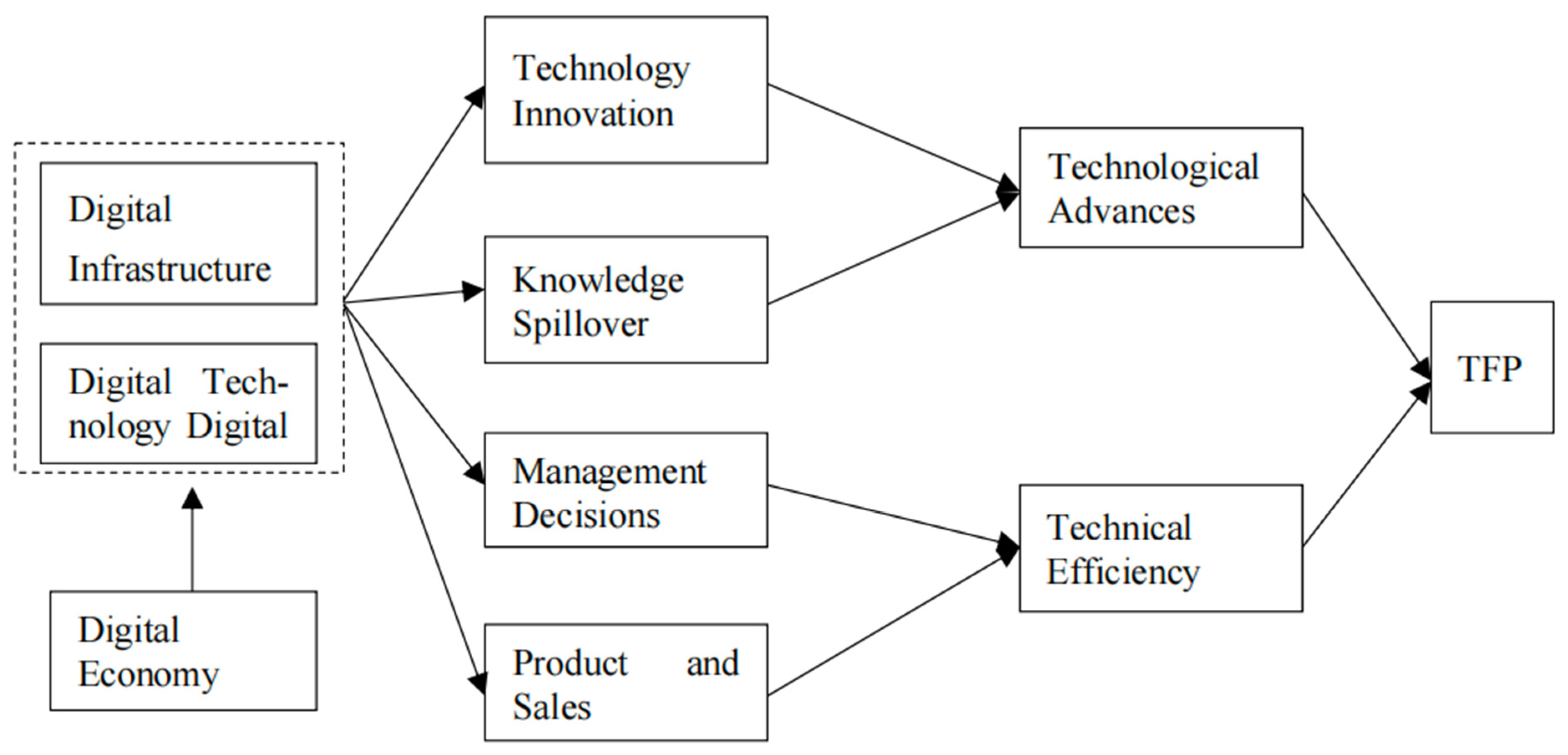
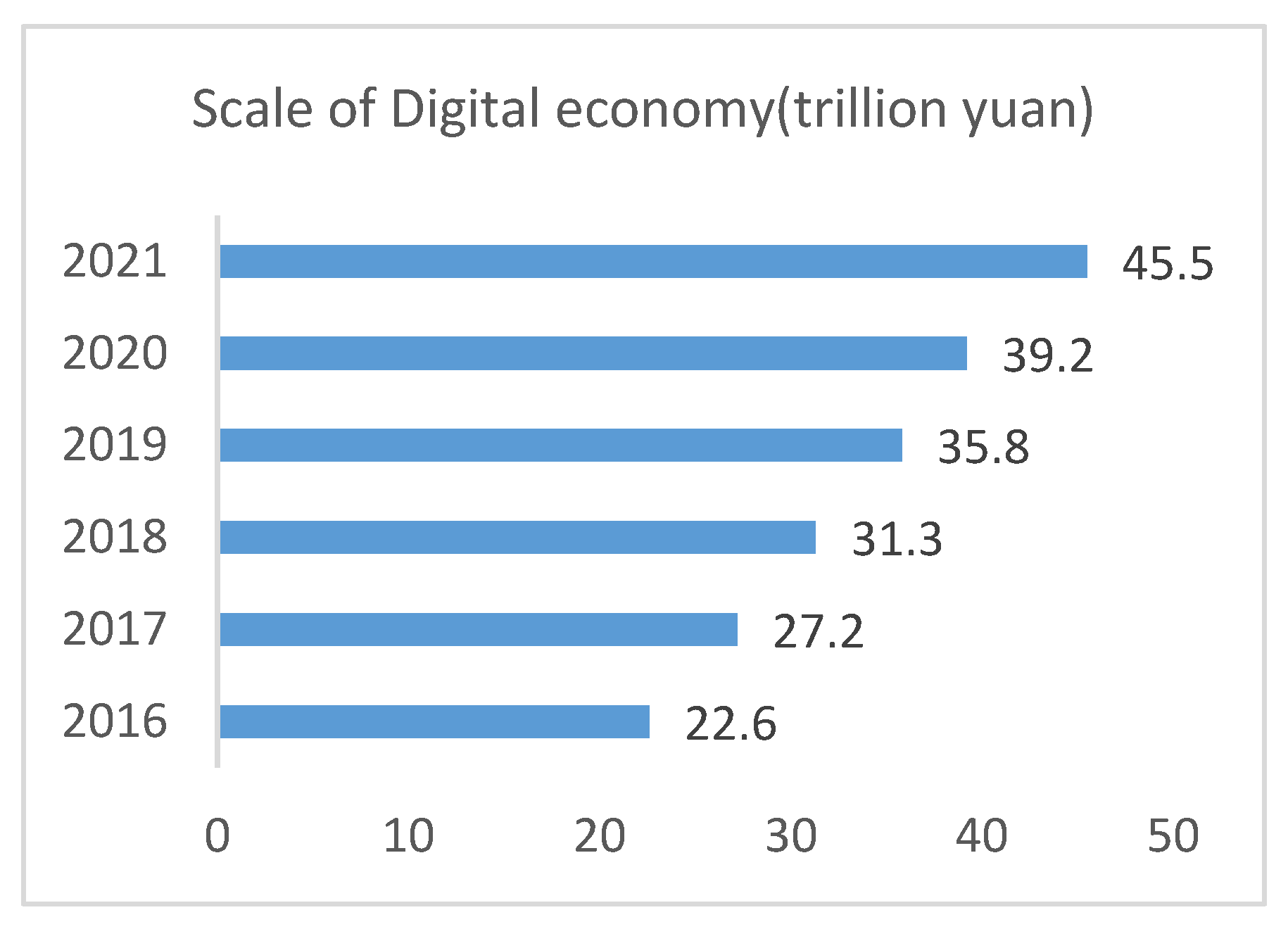
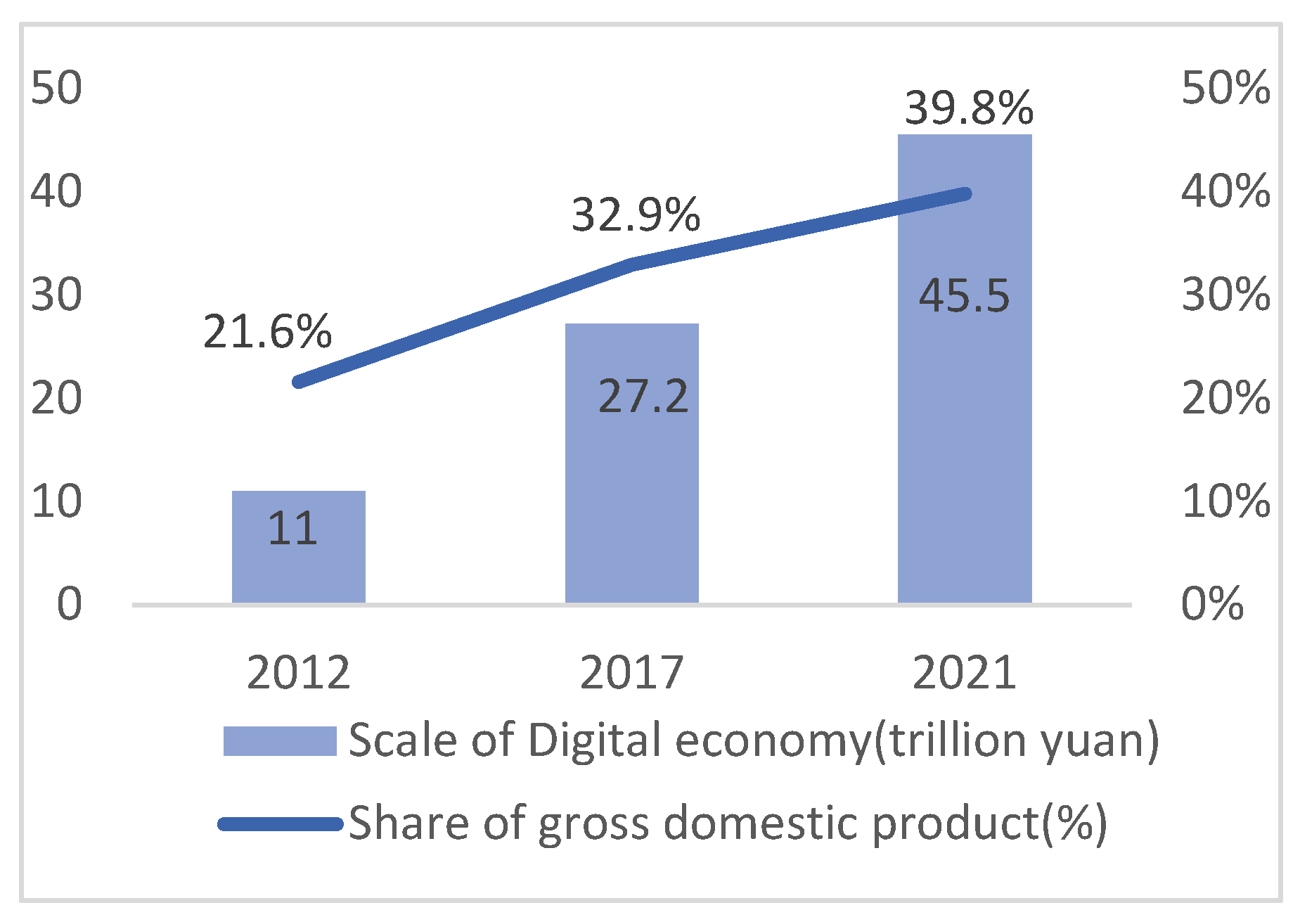


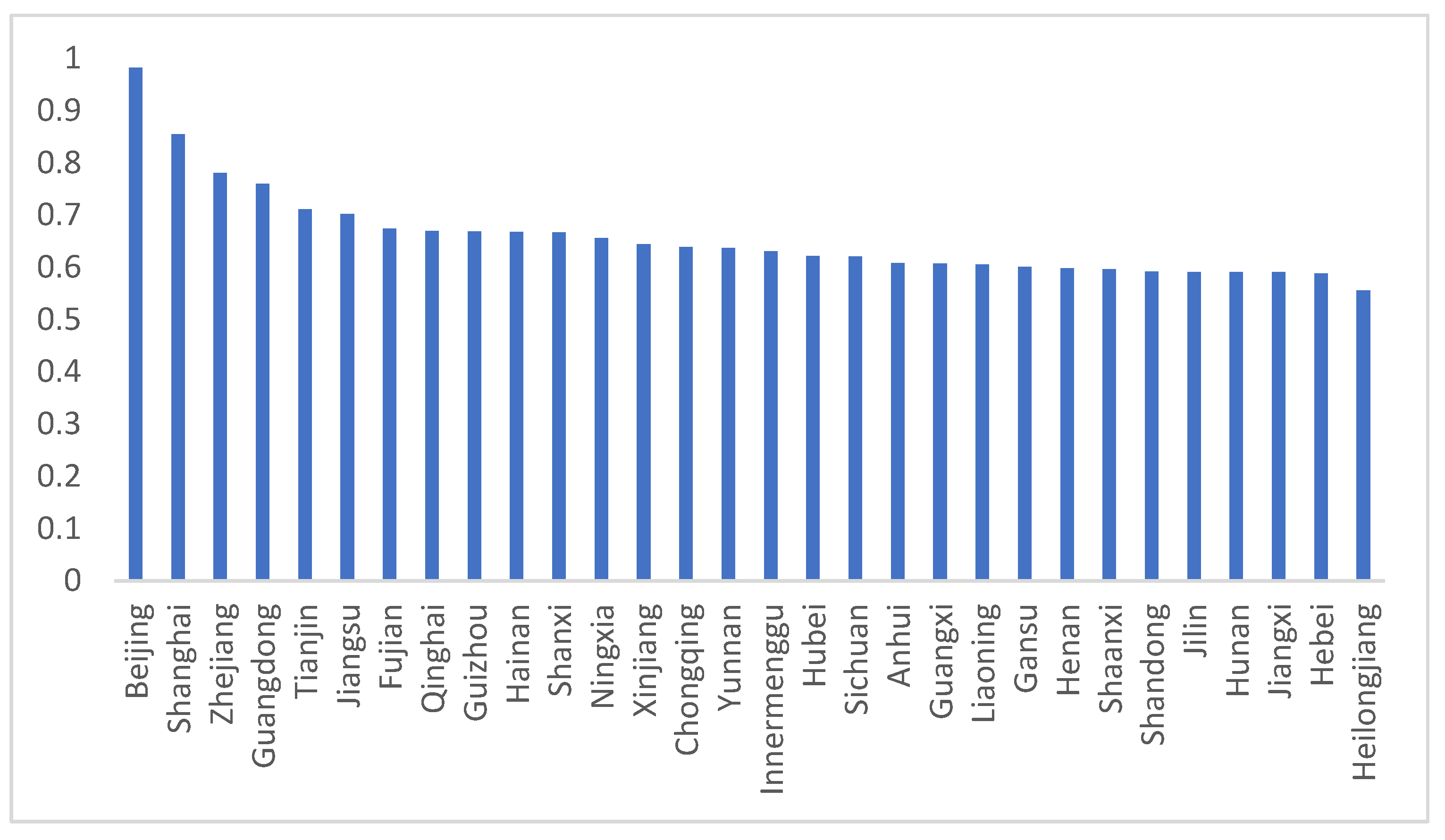
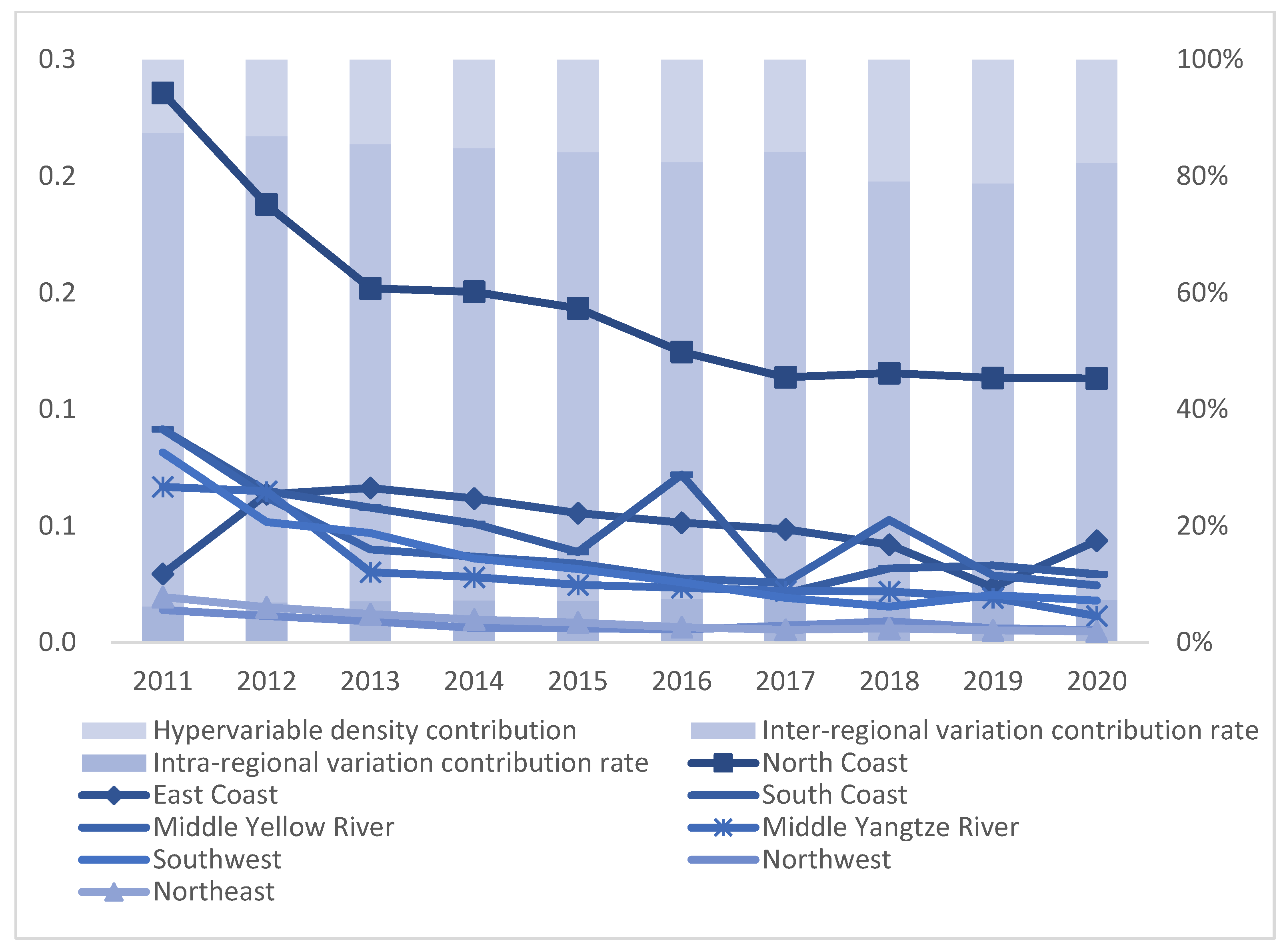
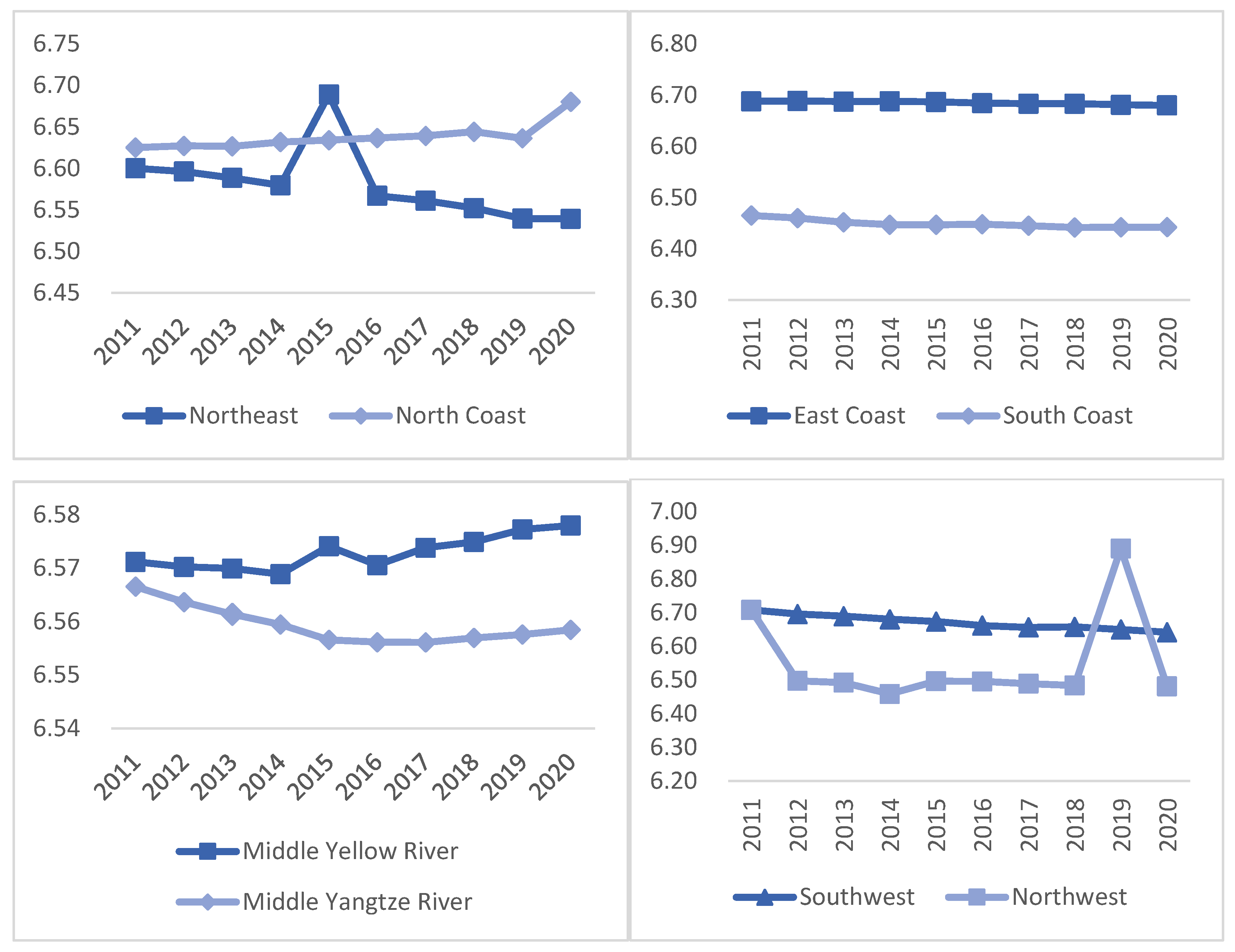
| Primary Indicators | Secondary Indicators | Tertiary Indicators |
|---|---|---|
| Digital Economy Index | Internet penetration rate | Internet users per 100 people |
| Number of Internet-related employees | Computer services and software | |
| Internet related output | Total telecom service per capita | |
| Mobile Internet Users | Mobile phone users per 100 people | |
| Inclusive development of digital finance | China Digital Financial Inclusion Index |
| Year | Northeast | North Coast | East Coast | South Coast | Middle Yellow River | Middle Yangtze River | Southwest | Northwest |
|---|---|---|---|---|---|---|---|---|
| 2011 | 0.1775 | 0.2205 | 0.1718 | 0.1149 | 0.0964 | 0.0964 | 0.1024 | 0.1235 |
| 2012 | 0.2472 | 0.2706 | 0.2375 | 0.1793 | 0.1468 | 0.1590 | 0.1651 | 0.1858 |
| 2013 | 0.3148 | 0.3512 | 0.3073 | 0.2267 | 0.2231 | 0.2231 | 0.2284 | 0.2499 |
| 2014 | 0.3440 | 0.3782 | 0.3322 | 0.2722 | 0.2588 | 0.2547 | 0.2587 | 0.2843 |
| 2015 | 0.3934 | 0.4312 | 0.3863 | 0.3172 | 0.2998 | 0.3030 | 0.3099 | 0.3306 |
| 2016 | 0.3950 | 0.4211 | 0.3613 | 0.3272 | 0.3110 | 0.3112 | 0.3058 | 0.3352 |
| 2017 | 0.4579 | 0.4579 | 0.4250 | 0.3831 | 0.3730 | 0.3770 | 0.3721 | 0.3948 |
| 2018 | 0.5560 | 0.6068 | 0.5555 | 0.4970 | 0.4560 | 0.4695 | 0.4667 | 0.4618 |
| 2019 | 0.6485 | 0.6772 | 0.6424 | 0.5592 | 0.5414 | 0.5605 | 0.5637 | 0.5322 |
| 2020 | 0.7183 | 0.7790 | 0.7005 | 0.6231 | 0.6027 | 0.6346 | 0.6425 | 0.5841 |
| 2011 | 0.1775 | 0.2205 | 0.1718 | 0.1149 | 0.0964 | 0.0964 | 0.1024 | 0.1235 |
| Year | Overall | Intra-Regional | Inter-Regional | Hyper Density | |||
|---|---|---|---|---|---|---|---|
| Source | Contribution Rate | Source | Contribution Rate | Source | Contribution Rate | ||
| 2011 | 0.204 | 0.013 | 6.196% | 0.166 | 81.272% | 0.026 | 12.532% |
| 2012 | 0.149 | 0.010 | 6.893% | 0.119 | 79.924% | 0.020 | 13.184% |
| 2013 | 0.114 | 0.008 | 7.052% | 0.089 | 78.427% | 0.017 | 14.522% |
| 2014 | 0.100 | 0.007 | 7.220% | 0.077 | 77.578% | 0.015 | 15.203% |
| 2015 | 0.091 | 0.007 | 7.151% | 0.070 | 76.957% | 0.014 | 15.892% |
| 2016 | 0.081 | 0.006 | 7.483% | 0.061 | 74.921% | 0.014 | 17.596% |
| 2017 | 0.068 | 0.005 | 7.463% | 0.052 | 76.680% | 0.011 | 15.857% |
| 2018 | 0.074 | 0.006 | 7.568% | 0.053 | 71.505% | 0.016 | 20.927% |
| 2019 | 0.063 | 0.005 | 7.639% | 0.045 | 71.102% | 0.013 | 21.259% |
| 2020 | 0.064 | 0.005 | 7.262% | 0.048 | 74.978% | 0.011 | 17.760% |
| Mean | 0.101 | 0.007 | 7.192% | 0.078 | 76.334% | 0.016 | 16.473% |
| Regions | Gini Coefficient | Regions | Gini Coefficient |
|---|---|---|---|
| North Coast—East Coast | 0.1397 | South Coast—Middle Yangtze River | 0.1336 |
| North Coast—South Coast | 0.1252 | South Coast—Southwest | 0.1247 |
| North Coast—Middle Yellow River | 0.1336 | South Coast—Southeast | 0.1175 |
| North Coast—Middle Yangtze River | 0.1539 | South Coast—Northeast | 0.0979 |
| North Coast—Southwest | 0.1494 | Middle Yangtze River—Middle Yellow River | 0.0539 |
| North Coast—Southeast | 0.1442 | Middle Yellow River—Southeast | 0.0514 |
| North Coast—Northeast | 0.1288 | Middle Yellow River—Southwest | 0.0486 |
| East Coast—South Coast | 0.0772 | Middle Yellow River—Northeast | 0.0493 |
| East Coast—Middle Yellow River | 0.1576 | Middle Yangtze River—Southeast | 0.0378 |
| East Coast—Middle Yangtze River | 0.1941 | Middle Yangtze River—Southwest | 0.0410 |
| East Coast—Southwest | 0.1853 | Middle Yangtze River—Northeast | 0.0564 |
| East Coast—Northwest | 0.1788 | Southeast—Southwest | 0.0384 |
| East Coast—Northeast | 0.1534 | Southwest—Northeast | 0.0564 |
| South Coast—Middle Yellow River | 0.0985 | Northwest—Northeast | 0.0521 |
| Year | Northeast | North Coast | East Coast | South Coast | Middle Yellow River | Middle Yangtze River | Southwest | Northwest |
|---|---|---|---|---|---|---|---|---|
| 2011 | 6.6001 | 6.6252 | 6.6880 | 6.4652 | 6.5711 | 6.5665 | 6.7082 | 6.7082 |
| 2012 | 6.5962 | 6.6271 | 6.6890 | 6.4600 | 6.5702 | 6.5636 | 6.6956 | 6.4975 |
| 2013 | 6.5885 | 6.6267 | 6.6876 | 6.4519 | 6.5699 | 6.5614 | 6.6892 | 6.4922 |
| 2014 | 6.5796 | 6.6318 | 6.6881 | 6.4471 | 6.5689 | 6.5594 | 6.6804 | 6.4586 |
| 2015 | 6.6892 | 6.6340 | 6.6868 | 6.4469 | 6.5741 | 6.5565 | 6.6735 | 6.4964 |
| 2016 | 6.5669 | 6.6366 | 6.6843 | 6.4479 | 6.5705 | 6.5561 | 6.6615 | 6.4957 |
| 2017 | 6.5610 | 6.6392 | 6.6833 | 6.4453 | 6.5738 | 6.5561 | 6.6561 | 6.4890 |
| 2018 | 6.5522 | 6.6442 | 6.6833 | 6.4416 | 6.5749 | 6.5569 | 6.6575 | 6.4836 |
| 2019 | 6.5396 | 6.6363 | 6.6813 | 6.4421 | 6.5772 | 6.5575 | 6.6497 | 6.8900 |
| 2020 | 6.5391 | 6.6803 | 6.6803 | 6.4424 | 6.5780 | 6.5584 | 6.6418 | 6.4810 |
| Explanatory Variables | OLS | FE |
|---|---|---|
| (1) | (2) | |
| DIGI | 0.025 *** (5.6) | 0.0841 ** (2.22) |
| GDP | 0.0816 *** (5.99) | |
| Finance | 0.0007 *** (8.93) | |
| FDI | 0.0024 * (1.92) | |
| R&D | 0.0005 *** (5.08) | |
| Cons | 0.2028 (0.67) | 0.5933 ** (2.38) |
| Year-fixed | No | Controls |
| Individual-fixed | No | Controls |
| N | 1849 | 1849 |
| R2 | 0.7280 | 0.7144 |
| Explanatory Variables | Adding Control Variables | Sample of Municipalities Excluded | Adjusted Sample Period | Split Sample Regression |
|---|---|---|---|---|
| Digi | 0.6316 *** (2.60) | 0.6906 *** (2.89) | 1.4238 ** (2.57) | 2.5811 *** (3.22) |
| GFP | −0.2.76 (−1.23) | 0.0001 *** (18.75) | 0.0001 ** (2.60) | 0.0413 * (0.00) |
| Finance | 0.0001 *** (9.02) | 0.181 *** (−3.84) | 0.0002 *** (7.06) | 0.0001 *** (5.08) |
| FDI | 0.171 *** (3.57) | 0.692 * (2.36) | 0.0182 (0.74) | 0.0001 *** (5.85) |
| R&D | 7.22 (1.42) | 0.0001 *** (2.76) | 0.0001 (1.50) | 0.0002 ** (2.30) |
| Government | 0.0001 *** (2.39) | |||
| Cons | 3.8667 ** (2.39) | 4.2474 *** (2.67) | 9.4008 ** (2.56) | 1.7323 *** (3.25) |
| Year-fixed | Controls | Controls | Controls | Controls |
| Individual-fixed | Controls | Controls | Controls | Controls |
| R2 | 0.7296 | 0.7275 | 0.7068 | 0.7593 |
| Explanatory Variables | (1) T + 1 | (2) T + 2 | (3) T + 3 |
|---|---|---|---|
| Digi | 0.8352 *** (3.05) | 0.8060 *** (2.60) | 0.9226 *** (2.61) |
| Cons | 5.2423 *** | 5.0577 ** | 5.7608 ** |
| N | 1849 | 1849 | 1849 |
| Year-fixed | Controls | Controls | Controls |
| Individual-fixed | Controls | Controls | Controls |
| R2 | 0.6989 | 0.6722 | 0.6731 |
| Northeast | North Coast | East Coast | South Coast | Middle Yellow River | Middle Yangtze River | Southwest | Northwest | |
|---|---|---|---|---|---|---|---|---|
| (1) | (2) | (3) | (4) | (5) | (6) | (7) | (8) | |
| Digi | 0.2059 *** (4.12) | 0.2184 *** (4.32) | 0.08638 *** (5.27) | 0.0836 ** (2.59) | 0.0566 * (1.80) | 0.2157 *** (3.72) | 0.0478 (1.19) | 0.0356 (0.67) |
| Controls | YES | YES | YES | YES | YES | YES | YES | YES |
| Cons | 22.7697 | 62.37 | 23.63 | 9.23 | 10.7397 | 14.6717 | 8.3706 | 1.4996 |
| R2 | 0.8480 | 0.9505 | 0.8748 | 0.9272 | 0.9694 | 0.9237 | 0.7519 | 0.9388 |
Disclaimer/Publisher’s Note: The statements, opinions and data contained in all publications are solely those of the individual author(s) and contributor(s) and not of MDPI and/or the editor(s). MDPI and/or the editor(s) disclaim responsibility for any injury to people or property resulting from any ideas, methods, instructions or products referred to in the content. |
© 2023 by the authors. Licensee MDPI, Basel, Switzerland. This article is an open access article distributed under the terms and conditions of the Creative Commons Attribution (CC BY) license (https://creativecommons.org/licenses/by/4.0/).
Share and Cite
Chang, J.; Lan, Q.; Tang, W.; Chen, H.; Liu, J.; Duan, Y. Research on the Impact of Digital Economy on Manufacturing Total Factor Productivity. Sustainability 2023, 15, 5683. https://doi.org/10.3390/su15075683
Chang J, Lan Q, Tang W, Chen H, Liu J, Duan Y. Research on the Impact of Digital Economy on Manufacturing Total Factor Productivity. Sustainability. 2023; 15(7):5683. https://doi.org/10.3390/su15075683
Chicago/Turabian StyleChang, Jiaqi, Qingxin Lan, Wan Tang, Hailong Chen, Jun Liu, and Yunpeng Duan. 2023. "Research on the Impact of Digital Economy on Manufacturing Total Factor Productivity" Sustainability 15, no. 7: 5683. https://doi.org/10.3390/su15075683
APA StyleChang, J., Lan, Q., Tang, W., Chen, H., Liu, J., & Duan, Y. (2023). Research on the Impact of Digital Economy on Manufacturing Total Factor Productivity. Sustainability, 15(7), 5683. https://doi.org/10.3390/su15075683




